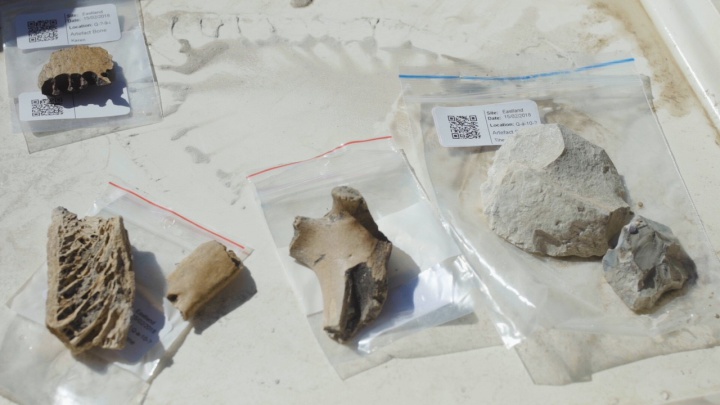Old Māori village discovered by Otago archaeologists
Old Māori village discovered by Otago archaeologists
A group of University of Otago archaeologists have uncovered the peripheries of a 14th century Māori village in Gisborne.
The
University’s Southern Pacific Archaeological Research
(SPAR) unit has recently completed it’s third visit to
Eastland Port in Gisborne. Heritage New Zealand granted
archaeological consent to the Port in 2016, as part of an
ongoing redevelopment project.
Bone and artefacts from the
site. The bone is food remains and includes a piece of moa
bone at the bottom left. The top left is part of a dog jaw
(PHOTO: Cinema East).
Among the findings in the 2.5 metre-deep excavation were moa bones and other food items, fish hooks manufactured of moa bone and stone tools made of obsidian and chert. The site was located on the edge of an old riverbed. The obsidian (volcanic glass) was used by early Māori settlers as simple cutting tools. The materials found are estimated to date back to the early 1300s.
University of Otago Professor of Archaeology Richard Walter says uncovering the site is significant from a scientific and cultural perspective.
“We don’t know as much about the early occupation around this part of the coastline as we do in other parts of the country,” says Professor Walter.
“There are not too many of these very,
early sites and so this one is filling the gaps.”
The
area has a significant history as the first landing place of
waka (canoes) which carried Maori to the district; and the
first contact between Māori and explorer James Cook taking
place on the river in 1769. Plans are underway to
commemorate the 250th anniversary next year.
Professor
Walter says given the amount of material found at the site,
the chances of finding a village within the vicinity are
quite high.
The site was identified through Heritage New Zealand Pouhere Taonga’s archaeological consent process, which regulates the modification or destruction of archaeological sites.
“This really is a great example of
the archaeological consent process working well where all
the groups involved have been working together to get the
best possible outcome for this very important place,” says
Heritage New Zealand Pouhere Taonga’s Director Regional
Services Pam Bain.
Eastland Port
received consent from Gisborne District Council in 2017 to
develop the wharfside log yard. The site is now being
re-covered with the knowledge that any ongoing
redevelopments within the port will not affect the historic
site.
The artefacts and faunal remains are being analysed by the SPAR team in the Otago Archaeology Laboratories in the University’s Richardson Building, before the process begins to return them to their rightful owners.
A report is expected to be published on the findings at a later date.


 Gordon Campbell: On The Hikoi Aftermath
Gordon Campbell: On The Hikoi Aftermath Free Speech Union: Fair Digital News Bargaining Bill Likely To Restrict Access To Information, Polling Shows Most Oppose
Free Speech Union: Fair Digital News Bargaining Bill Likely To Restrict Access To Information, Polling Shows Most Oppose Auckland Transport: Driver Safety Screens Now Rolling Out Across Auckland’s Bus Fleet
Auckland Transport: Driver Safety Screens Now Rolling Out Across Auckland’s Bus Fleet People Against Prisons Aotearoa: 'Expect Resistance' - Community Group Pushes Back Against More Cops With Guns
People Against Prisons Aotearoa: 'Expect Resistance' - Community Group Pushes Back Against More Cops With Guns Greenpeace: New Zealand Drops In Global Ranking On Climate Action
Greenpeace: New Zealand Drops In Global Ranking On Climate Action PSA: Spending Cuts Need To Stop - PSA Urges Govt To Listen To Economists
PSA: Spending Cuts Need To Stop - PSA Urges Govt To Listen To Economists Stats NZ: National Population Estimates: At 30 September 2024 (2018-base)
Stats NZ: National Population Estimates: At 30 September 2024 (2018-base)


